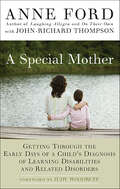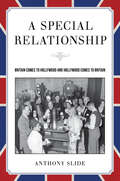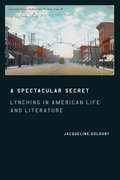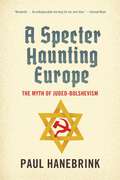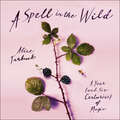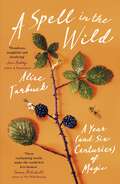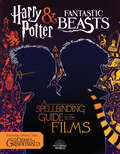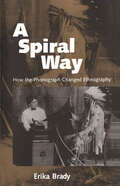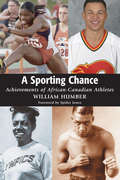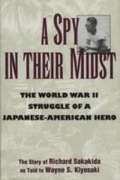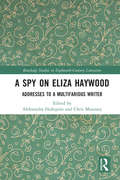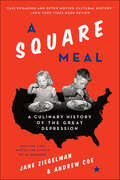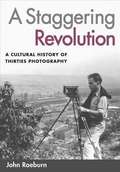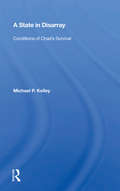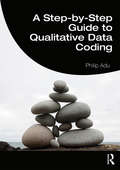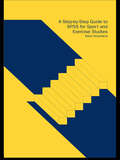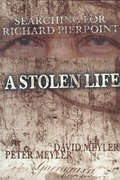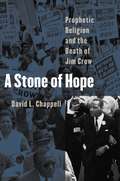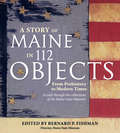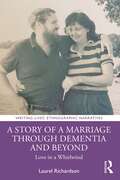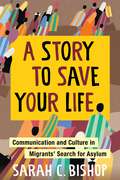- Table View
- List View
A Special Mother: Getting Through the Early Days of a Child's Diagnosis of Learning Disabilities and Related Disorders
by Anne Ford John-Richard ThompsonAll mothers experience worries and fears about their children, but none can compare with the early days when a mother feels something's not quite right. Anne Ford knows the feeling. She's had it herself, having raised a daughter with severe learning disabilities, and has gone on to share experiences with others during her many years as a volunteer with the National Center for Learning Disabilities.To bring comfort, support, and hard information to mothers-and fathers, too-in the early period surrounding the diagnosis, here is the book that Anne wishes she'd had years ago when she first received the news about her daughter and didn't know where to turn for the practical and emotional help she desperately needed.Filled with essential advice and the voices of other mothers whose children have LD and related disorders such as Asperger's and ADHD, A Special Mother lets parents know they are not alone and that they can help their child to thrive. This invaluable book addresses such matters as:Understanding Learning Disabilities and Related DisordersWhat Should You Do First?Interpreting Evaluation ResultsResolving DisputesSpecial Fathers: They Are Out ThereThe Social Side of LDAdvocacy vs. ObsessionHow Are You Doing?: Taking Care of Yourself
A Special Relationship: Britain Comes to Hollywood and Hollywood Comes to Britain
by Anthony SlideA Special Relationship provides not only a historical overview of the British in Hollywood, but also a detailed study of the contributions made by American individuals and companies to British cinema from the beginning of the twentieth century onwards. The story begins with Ohio-born Charles Urban who came to London in 1898 and deserves credit for major involvement in the creation of a British film industry. While Ireland was still a part of Britain, the New York-based Kalem Company made films there from 1910 to 1913. British producers realized the importance of American stars, and many actors, beginning with Florence Turner (who was arguably also the first American star), made numerous British films. In the 1920s, such Hollywood stars as Mae Marsh, Betty Blythe, and Dorothy Gish remained active in Britain. In the 1930s, as their careers came to a halt, more than one hundred former American stars made the trip to England, partly as a vacation and partly in the hope of reenergizing their careers.Chapters discuss American cinematographers at work in Britain in the 1920s and 1930s and the introduction of Technicolor to British films. Diversity is represented by African American performers (most notably Paul Robeson), the Chinese American star Anna May Wong, along with female filmmakers from Hollywood. With Britain's declaration of war on Germany, there were Americans who stayed, such as Bebe Daniels and Ben Lyon, contributing to the war effort. America became actively involved in British cinema after World War II, with many Hollywood studios producing films there. As the years progressed, the British film industry became an international film industry. The book concludes with the Harry Potter and James Bond series, indicative of a new international cinema, with financing and behind-the-camera talent coming from the United States, but with British locales and British stars.
A Spectacular Secret: Lynching in American Life and Literature
by Jacqueline GoldsbyThis incisive study takes on one of the grimmest secrets in America's national life—the history of lynching and, more generally, the public punishment of African Americans. Jacqueline Goldsby shows that lynching cannot be explained away as a phenomenon peculiar to the South or as the perverse culmination of racist politics. Rather, lynching—a highly visible form of social violence that has historically been shrouded in secrecy—was in fact a fundamental part of the national consciousness whose cultural logic played a pivotal role in the making of American modernity. To pursue this argument, Goldsby traces lynching's history by taking up select mob murders and studying them together with key literary works. She focuses on three prominent authors—Ida B. Wells-Barnett, Stephen Crane, and James Weldon Johnson—and shows how their own encounters with lynching influenced their analyses of it. She also examines a recently assembled archive of evidence—lynching photographs—to show how photography structured the nation's perception of lynching violence before World War I. Finally, Goldsby considers the way lynching persisted into the twentieth century, discussing the lynching of Emmett Till in 1955 and the ballad-elegies of Gwendolyn Brooks to which his murder gave rise. An empathic and perceptive work, A Spectacular Secret will make an important contribution to the study of American history and literature.
A Spectacular Secret: Lynching in American Life and Literature
by Jacqueline GoldsbyThis incisive study takes on one of the grimmest secrets in America's national life—the history of lynching and, more generally, the public punishment of African Americans. Jacqueline Goldsby shows that lynching cannot be explained away as a phenomenon peculiar to the South or as the perverse culmination of racist politics. Rather, lynching—a highly visible form of social violence that has historically been shrouded in secrecy—was in fact a fundamental part of the national consciousness whose cultural logic played a pivotal role in the making of American modernity. To pursue this argument, Goldsby traces lynching's history by taking up select mob murders and studying them together with key literary works. She focuses on three prominent authors—Ida B. Wells-Barnett, Stephen Crane, and James Weldon Johnson—and shows how their own encounters with lynching influenced their analyses of it. She also examines a recently assembled archive of evidence—lynching photographs—to show how photography structured the nation's perception of lynching violence before World War I. Finally, Goldsby considers the way lynching persisted into the twentieth century, discussing the lynching of Emmett Till in 1955 and the ballad-elegies of Gwendolyn Brooks to which his murder gave rise. An empathic and perceptive work, A Spectacular Secret will make an important contribution to the study of American history and literature.
A Spectacular Secret: Lynching in American Life and Literature
by Jacqueline GoldsbyThis incisive study takes on one of the grimmest secrets in America's national life—the history of lynching and, more generally, the public punishment of African Americans. Jacqueline Goldsby shows that lynching cannot be explained away as a phenomenon peculiar to the South or as the perverse culmination of racist politics. Rather, lynching—a highly visible form of social violence that has historically been shrouded in secrecy—was in fact a fundamental part of the national consciousness whose cultural logic played a pivotal role in the making of American modernity. To pursue this argument, Goldsby traces lynching's history by taking up select mob murders and studying them together with key literary works. She focuses on three prominent authors—Ida B. Wells-Barnett, Stephen Crane, and James Weldon Johnson—and shows how their own encounters with lynching influenced their analyses of it. She also examines a recently assembled archive of evidence—lynching photographs—to show how photography structured the nation's perception of lynching violence before World War I. Finally, Goldsby considers the way lynching persisted into the twentieth century, discussing the lynching of Emmett Till in 1955 and the ballad-elegies of Gwendolyn Brooks to which his murder gave rise. An empathic and perceptive work, A Spectacular Secret will make an important contribution to the study of American history and literature.
A Specter Haunting Europe: The Myth of Judeo-Bolshevism
by Paul HanebrinkIn the 20th century, Europe was haunted by a specter of its own imagining: Judeo-Bolshevism. Fear of a Jewish Bolshevik plot to destroy the nations of Europe took hold during the Russian Revolution and spread across the continent. Paul Hanebrink shows that the myth of ethno-religious threat is still alive today, in Westerners’ fear of Muslims.
A Spell in the Wild: A Year (and six centuries) of Magic
by Alice Tarbuck'Witches occupy a clear place in contemporary imagination. We can see them, shadowy, in the corners of the past: mad, glamorous, difficult, strange. They haunt the footnotes of history - from medieval witches burning at the stake to the lurid glamour of the 1970s witchcraft revival. But they are moving out of history, too. Witches are back. They're feminist, independent, invested in self-care and care for the world. They are here, because they must be needed.'What it means to be a witch has changed radically throughout history; where 'witch' was once a dangerous - and often deadly - accusation, it is now a proud self-definition. Today, as the world becomes ever more complicated and as we face ecological, political and economic crisis - witchcraft is experiencing a resurgence. Witches are back.In A Spell in the Wild, Alice Tarbuck explores what it means to be a witch today. Rooted in the real world, but filled with spells, rituals and recipes, this book is an accessible, seasonal guide to witchcraft in the twenty-first century. Following the course of a witch's calendar year while also exploring the history and politics of witchcraft, A Spell in the Wild is the perfect primer for the contemporary witch.(P) 2020 Hodder & Stoughton Ltd
A Spell in the Wild: A Year (and six centuries) of Magic
by Alice Tarbuck'Witches occupy a clear place in contemporary imagination. We can see them, shadowy, in the corners of the past: mad, glamorous, difficult, strange. They haunt the footnotes of history - from medieval witches burning at the stake to the lurid glamour of the 1970s witchcraft revival. But they are moving out of history, too. Witches are back. They're feminist, independent, invested in self-care and care for the world. They are here, because they must be needed.'What it means to be a witch has changed radically throughout history; where 'witch' was once a dangerous - and often deadly - accusation, it is now a proud self-definition. Today, as the world becomes ever more complicated and as we face ecological, political and economic crisis - witchcraft is experiencing a resurgence. Witches are back.In A Spell in the Wild, Alice Tarbuck explores what it means to be a witch today. Rooted in the real world, but filled with spells, rituals and recipes, this book is an accessible, seasonal guide to witchcraft in the twenty-first century. Following the course of a witch's calendar year while also exploring the history and politics of witchcraft, A Spell in the Wild is the perfect primer for the contemporary witch.
A Spell in the Wild: A Year (and six centuries) of Magic
by Alice Tarbuck'Witches occupy a clear place in contemporary imagination. We can see them, shadowy, in the corners of the past: mad, glamorous, difficult, strange. They haunt the footnotes of history - from medieval witches burning at the stake to the lurid glamour of the 1970s witchcraft revival. But they are moving out of history, too. Witches are back. They're feminist, independent, invested in self-care and care for the world. They are here, because they must be needed.'What it means to be a witch has changed radically throughout history; where 'witch' was once a dangerous - and often deadly - accusation, it is now a proud self-definition. Today, as the world becomes ever more complicated and as we face ecological, political and economic crisis - witchcraft is experiencing a resurgence. Witches are back.In A Spell in the Wild, Alice Tarbuck explores what it means to be a witch today. Rooted in the real world, but filled with spells, rituals and recipes, this book is an accessible, seasonal guide to witchcraft in the twenty-first century. Following the course of a witch's calendar year while also exploring the history and politics of witchcraft, A Spell in the Wild is the perfect primer for the contemporary witch.
A Spellbinding Guide to the Films (Follow Me Around... Ser.)
by Michael KoggeFantastic Beasts: The Crimes of Grindelwald is coming to theaters November 16, 2018! Explore the new film series and its connections to Harry Potter with this beautiful handbook!As Fantastic Beasts: The Crimes of Grindelwald breaks new ground, it's time to get up to speed on the films of J.K. Rowling's wizarding world! This handy handbook has everything fans need to sort hippogriffs from horcruxes, trace the lineage of the most noble wizarding families, explore the different wizarding governments, and study Hogwarts from the early 1900s on. This beautiful guide is the perfect deep dive into Harry Potter and Fantastic Beasts and how the two worlds are connected, complete with family trees, infographics, and more.
A Spiral Way: How the Phonograph Changed Ethnography
by Erika BradyAssociation of Recorded Sound Collections Awards for ExcellenceBest Research in the General History of Recorded Sound (2000)The invention of the cylinder phonograph at the end of the nineteenth century opened up a new world for cultural research. Indeed, Edison's talking machine became one of the basic tools of anthropology. It not only equipped researchers with the means of preserving folk songs but it also enabled them to investigate a wide spectrum of distinct vocal expressions in the emerging fields of anthropology and folklore. Ethnographers grasped its huge potential and fanned out through regional America to record rituals, stories, word lists, and songs in isolated cultures. From the outset the federal government helped fuel the momentum to record cultures that were at risk of being lost. Through the Bureau of American Ethnology, the Smithsonian Institution took an active role in preserving native heritage. It supported projects to make phonographic documentation of American Indian language, music, and rituals before developing technologies and national expansion might futher undermine them. This study of the early phonograph's impact shows traditional ethnography being transformed, for attitudes of both ethnographers and performers were reshaped by this exciting technology. In the presence of the phonograph both fieldwork and the materials collected were revolutionized. By radically altering the old research modes, the phonograph brought the disciplines of anthropology and folklore into the modern era. At first the instrument was as strange and new to the fieldworkers as it was to their subjects. To some the first encounter with the phonograph was a deeply unsettling experience. When it was demonstrated in 1878 before members of the National Academy of Sciences, several members of the audience fainted. Even its inventor was astonished. Of his first successful test of his tinfoil phonograph, Thomas A. Edison said, "I was never taken so aback in my life." The cylinders that have survived from these times offer an unrivaled resource not only for contemporary scholarship but also for a grassroots renaissance of cultural and religious values. In tracing the historical interplay of the talking machine with field research, A Spiral Way underscores the natural adaptablity of cultural study to this new technology.
A Sporting Chance: Achievements of African-Canadian Athletes
by William Humber Spider JonesOver the years, Canadians have smugly asserted their country’s more tolerant culture in race relations. Yet as this story of African-Canadian participation in sports demonstrates, the record is far more troubling. In reality, Canada’s record in matters of race was a disturbing blend of occasional good intentions and ugly practices. The study of the Black athletic experience in Canada is not only a revealing portrait into our past, but also one more demonstration of some time-honoured truths about human achievement and the necessity of the public will to provide open and fair forums for equal access to participation. Presented in a chronological sequence, individual sports are presented along with the leading athletes who brought grace and a determination to achieve. Included are George Dixon, Sam Langford, Reuben Mayes, Ray Lewis, Sam Richardson, Dr. Phil Edwards, Jackie Robinson, Harry Jerome, Earl Walls, Donovan Bailey, Sylvia Sweeney, Molly Killingbeck, Herb Carnegie, Jamaal Magliore, Perdita Felicien and Jarome Iginla, to name but a few of the fine athletes who form a part of Canada’s sports heritage. "As Canada’s foremost baseball historian, Bill Humber has chronicled another fascinating chapter from Canada’s rich sports history. This is an excellent read – entertaining, educational and expertly researched. As my pal Don Cherry might say: ’Two thumbs up, Bill.’"– Brian McFarlane, Sports Family Ltd.
A Spy In Their Midst: The World War Ii Struggle Of A Japanese-american Hero
by Wayne S. Kiyosaki Richard Sakakida<P>During World War II, while thousands of Japanese-Americans were being sent to U.S. detainment camps, a Japanese-American from Hawaii working as a U.S. Army spy in the Philippines was captured by the enemy.<P> Richard Sakakida was the only Japanese-American prisoner of the Japanese forces, and he faced death as a "traitor" because of his Japanese face.<P> Despite unspeakable torture, Sakakida stubbornly refused to confess that he was an American spy; ironically, his Japanese cultural heritage is what enabled him to survive the beatings inflicted on him by his Japanese captors.<P> Sakakida narrowly escaped a death sentence and was assigned to the office of a Japanese official, where he gained valuable military information for MacArthur and engineered a daring prison break that freed a Filipino guerrilla leader and hundreds of his followers. <P>Fifty years later, Sakakida finally tells his tale of survival and perseverance against incredible odds.
A Spy on Eliza Haywood: Addresses to a Multifarious Writer (Routledge Studies in Eighteenth-Century Literature)
by Aleksondra HultquistEliza Haywood was one of the most prolific English writers in the Age of the Enlightenment. Her career, from Love in Excess (1719) to her last completed project The Invisible Spy (1755) spanned the gamut of genres: novels, plays, advice manuals, periodicals, propaganda, satire, and translations. Haywood’s importance in the development of the novel is now well-known. A Spy on Eliza Haywood links this with her work in the other genres in which she published at least one volume a year throughout her life, demonstrating how she contributed substantially to making women’s writing a locus of debate that had to be taken seriously by contemporary readers, as well as now by current scholars of political, moral, and social enquiries into the eighteenth century. Haywood’s work is essential to the study of eighteenth-century literature and this collection of essays continues the growing scholarship on this most important of women writers.
A Square Meal: A Culinary History of the Great Depression
by Jane Ziegelman Andrew CoeJames Beard Foundation Book Award WinnerFrom the author of the acclaimed 97 Orchard and her husband, a culinary historian, an in-depth exploration of the greatest food crisis the nation has ever faced—the Great Depression—and how it transformed America’s culinary culture.The decade-long Great Depression, a period of shifts in the country’s political and social landscape, forever changed the way America eats. Before 1929, America’s relationship with food was defined by abundance. But the collapse of the economy, in both urban and rural America, left a quarter of all Americans out of work and undernourished—shattering long-held assumptions about the limitlessness of the national larder.In 1933, as women struggled to feed their families, President Roosevelt reversed long-standing biases toward government-sponsored “food charity.” For the first time in American history, the federal government assumed, for a while, responsibility for feeding its citizens. The effects were widespread. Championed by Eleanor Roosevelt, “home economists” who had long fought to bring science into the kitchen rose to national stature.Tapping into America’s long-standing ambivalence toward culinary enjoyment, they imposed their vision of a sturdy, utilitarian cuisine on the American dinner table. Through the Bureau of Home Economics, these women led a sweeping campaign to instill dietary recommendations, the forerunners of today’s Dietary Guidelines for Americans.At the same time, rising food conglomerates introduced packaged and processed foods that gave rise to a new American cuisine based on speed and convenience. This movement toward a homogenized national cuisine sparked a revival of American regional cooking. In the ensuing decades, the tension between local traditions and culinary science has defined our national cuisine—a battle that continues today. A Square Meal examines the impact of economic contraction and environmental disaster on how Americans ate then—and the lessons and insights those experiences may hold for us today.A Square Meal features 25 black-and-white photographs.
A Staggering Revolution: A Cultural History of Thirties Photography
by John RaeburnDuring the 1930s, the world of photography was unsettled, exciting, and boisterous. John Raeburn's A Staggering Revolution recreates the energy of the era by surveying photography's rich variety of innovation, exploring the aesthetic and cultural achievements of its leading figures, and mapping the paths their pictures blazed public's imagination. While other studies of thirties photography have concentrated on the documentary work of the Farm Security Administration (FSA), no previous book has considered it alongside so many of the decade's other important photographic projects. A Staggering Revolution includes individual chapters on Edward Steichen's celebrity portraiture; Berenice Abbott's Changing New York project; the Photo League's ethnography of Harlem; and Edward Weston's western landscapes, made under the auspices of the first Guggenheim Fellowship awarded to a photographer. It also examines Margaret Bourke-White's industrial and documentary pictures, the collective undertakings by California's Group f.64, and the fashion magazine specialists, as well as the activities of the FSA and the Photo League.
A State In Disarray: Conditions Of Chad's Survival
by Michael P. KelleyAlthough independent since 1960, Chad has proved to be one of the least viable African states. Sustained politically and financially by other countries from the outset, Chad's internal warfare has made it the prey of external powers. Yet Chad has survived–an integral element of the Organization of African Unity's Pax Africana and of a peaceful trans-Saharan Africa. Its jeopardized survival is a shaky testimony to the continuing validity of the African continent's colonial-based states-system–underwritten by the OAU and the UN–and at the same time it provides a striking example of the cumulative effects of Africa's post-independence problems. Examining the state's internal weakness and the degree and nature of its foreign involvements, the author focuses on Chad's continuing dilemma: The outside support so crucial for viability is the very thing that undermines its international standing. The roles of Libya, France, the United States, the UN, the OAU, and the trans-Saharan regional subsystem are also analyzed as the author illuminates the quandary of supporting the state without aggravating its conflicts.
A Step-by-Step Guide to Applying the Rasch Model Using R: A Manual for the Social Sciences (Quantitative Methodology Series)
by Iasonas LamprianouThis new edition provides a step-by-step guide to applying the Rasch model in R, a probabilistic model used by researchers across the social sciences to measure unobservable (“latent”) variables. Although the focus is on simple R code, the book provides updated guidance through the point-and-click menus of BlueSky Statistics software.The book covers all Rasch models frequently used in social sciences, from the Simple Rasch model to the Rating Scale, Partial Credit, and Many-Facets Rasch models. Using a pragmatic approach to model-data fit, this book offers helpful practical examples to investigate Rasch model assumptions. In addition to traditional Rasch model approaches, it introduces the Rasch model as a special case of a Generalized Mixed Effects Model. Readers will also benefit from the online support material which includes all the code used in the book in downloadable and useable files.It also provides a comprehensive guide to R programming and practical guidance on using BlueSky Statistics software's point-and-click menus. This dual approach enables readers to experiment with data analysis using the provided data sets, enhancing their understanding and application of statistical concepts. It will be a valuable resource for both students and researchers who want to use Rasch models in their research.
A Step-by-Step Guide to Qualitative Data Coding
by Philip AduA Step-by-Step Guide to Qualitative Data Coding is a comprehensive qualitative data analysis guide. It is designed to help readers to systematically analyze qualitative data in a transparent and consistent manner, thus promoting the credibility of their findings. The book examines the art of coding data, categorizing codes, and synthesizing categories and themes. Using real data for demonstrations, it provides step-by-step instructions and illustrations for analyzing qualitative data. Some of the demonstrations include conducting manual coding using Microsoft Word and how to use qualitative data analysis software such as Dedoose, NVivo and QDA Miner Lite to analyze data. It also contains creative ways of presenting qualitative findings and provides practical examples. After reading this book, readers will be able to: Analyze qualitative data and present their findings Select an appropriate qualitative analysis tool Decide on the right qualitative coding and categorization strategies for their analysis Develop relationships among categories/themes Choose a suitable format for the presentation of the findings It is a great resource for qualitative research instructors and undergraduate and graduate students who want to gain skills in analyzing qualitative data or who plan to conduct a qualitative study. It is also useful for researchers and practitioners in the social and health sciences fields.
A Step-by-Step Guide to SPSS for Sport and Exercise Studies: A Step-by-Step Guide for Students
by Nikos NtoumanisSPSS is the international standard software package for data analysis in the social sciences. This book is the only SPSS guide designed specifically for students in the fields of sport, exercise and kinesiology. It Includes sport specific cases and data throughout.
A Stolen Life: Searching for Richard Pierpoint
by Peter Meyler David MeylerRichard Pierpoint or Captain Dick, as he was commonly known, emerges from the shadows of history in A Stolen Life: Searching for Richard Pierpoint. An African warrior who was captured at about age 16, Pierpoint lived his remaining years in exile. From his birth in Bundu (now part of Senegal) around 1744 until his death in rural Ontario in 1837, Pierpoint’s life allows us to glimpse the activity of an African involved in some of the world’s great events. "We are indebted to the authors for breathing life into this man, who though taken from his home early in his life still was able to make a significant contribution to the early history of Upper Canada. He fought, farmed and became a giant to the Black community. We thank you for a wonderful story of this often forgotten segment of Canadian history."— Wilma Morrison, Norval Johnson Heritage Library, Niagara Falls"Everybody knows about the Underground Railroad and the great many Black souls who emigrated to Canada via this route, but very few people know the brave Black men and women who put their lives on the line in defence of this country."— Ivor Christopher, Re-enactor, Runchey’s Company of Coloured Men"A well-researched and highly readable chronicle of Richard Pierpoint’s life in Africa and North America — as a slave, a soldier, and as a pioneer in Upper Canada’s wilderness. … a vitally important contribution to Canadian Black history."— Linda Brown-Kubisch, Author, Missouri
A Stone of Hope
by David L. ChappellThe civil rights movement was arguably the most successful social movement in American history. In a provocative new assessment of its success, David Chappell argues that the story of civil rights is not a story of the ultimate triumph of liberal ideas after decades of gradual progress. Rather, it is a story of the power of religious tradition.Chappell reconsiders the intellectual roots of civil rights reform, showing how northern liberals' faith in the power of human reason to overcome prejudice was at odds with the movement's goal of immediate change. Even when liberals sincerely wanted change, they recognized that they could not necessarily inspire others to unite and fight for it. But the prophetic tradition of the Old Testament--sometimes translated into secular language--drove African American activists to unprecedented solidarity and self-sacrifice. Martin Luther King Jr., Fannie Lou Hamer, James Lawson, Modjeska Simkins, and other black leaders believed, as the Hebrew prophets believed, that they had to stand apart from society and instigate dramatic changes to force an unwilling world to abandon its sinful ways. Their impassioned campaign to stamp out "the sin of segregation" brought the vitality of a religious revival to their cause. Meanwhile, segregationists found little support within their white southern religious denominations. Although segregationists outvoted and outgunned black integrationists, the segregationists lost, Chappell concludes, largely because they did not have a religious commitment to their cause.In a provocative assessment of the success of the civil rights movement, David Chappell reconsiders the intellectual roots of civil rights reform, showing how the prophetic tradition of the Old Testament--sometimes translated into secular language--drove African American activists to unprecedented solidarity and self-sacrifice. Martin Luther King Jr., Fannie Lou Hamer, James Lawson, Modjeska Simkins, and other black leaders believed, as the Hebrew prophets believed, that they had to stand apart from society and instigate dramatic changes to force an unwilling world to abandon its sinful ways. Although segregationists outvoted and outgunned black integrationists, the segregationists lost, Chappell concludes, largely because they did not have a religious commitment to their cause.-->
A Story of Maine in 112 Objects: From Prehistory To Modern Times
by Bernard P. FishmanPUBLISHED WITH THE MAINE STATE MUSEUM Founded in 1836, the Maine State Museum is America’s oldest state museum and is known to many as “Maine’s Smithsonian” because of the breadth and diversity of its holdings—nearly a million objects covering every aspect of the state’s cultural, biological, and geological history—and the thousands of stories its collections tell. For this book the museum selected and photographed 112 artifacts and specimens that, together, tell an epic story of the land and its people from prehistoric times to the present. It is a story covering 395 million years, a story told with a walrus skull and fossils, tourmaline and spear points, mammoth tusks and bone fishhooks, Norse coins and caulking irons, militia flags and survey stakes, treaty documents and wooden tankards, a temperance banner and a locomotive, Joshua Chamberlain’s pistol and a cod tub trawl, a Lombard log hauler and a woman’s WWII welding outfit, L. L. Bean boots and German POW snowshoes, and many more objects from the museum’s collections. Short narratives written by museum curators are woven around each item—including photos of related objects—and the ensemble has been honed, polished, and introduced by museum director Bernard Fishman. This is a book that historians and Maine residents and visitors will delve into again and again, unearthing new treasures with each reading.
A Story of a Marriage Through Dementia and Beyond: Love in a Whirlwind (Writing Lives: Ethnographic Narratives)
by Laurel RichardsonA Story of a Marriage Through Dementia and Beyond is the extraordinary, unflinching account from sociologist Laurel Richardson of her love and caregiving through the last period of her husband Ernest Lockridge's life - from his transient amnesia to his death from Lewy Body Dementia. Focusing on the lived experience of the caregiver through the loved one’s journey from mild cognitive impairment to death, the book gives the reader the experience of what the medical diagnoses mean and what has led up to the loss. It shows the complex, nuanced lives of a couple both living with the worst effects of a disease like Lewy Body Dementia, while maintaining, sometimes with hope and laughter, their loving connection nourished through a 40-year marriage. Dementia is a ‘silver tsunami’ - the third leading cause of death amongst senior populations. Richardson’s beautifully written book gives on-the-ground emotional support to those already in service as caregivers and helps prepare others for such service. Hospices, book clubs, and medical and allied professionals will find this book extraordinarily valuable. Weaving in autoethnographic and sociological methods and scholarship, as well as a list of reading and further resources for caregivers and scholars, this book will also appeal to courses in a wide range of disciplines and fields, including health communication, nursing and allied health, courses covering death and dying, end-of-life, and illness care, and, of course, scholars pursuing autoethnography, creative non-fiction, and qualitative methods.
A Story to Save Your Life: Communication and Culture in Migrants' Search for Asylum
by Sarah BishopA young woman flees violence in Mexico and seeks protection in the United States—only to be trafficked as a domestic worker in the Bronx. A decorated immigration judge leaves his post when the policies he proudly upheld capsize in the wake of political turmoil. A Gambian translator who was granted asylum herself talks with other African women about how immigration officers expect victims of torture to behave. A border patrol officer begins to question the training that instructs him to treat the children he finds in the Arizona desert like criminals.Through these and other powerful firsthand accounts, A Story to Save Your Life offers new insight into the harrowing realities of seeking protection in the United States. Sarah C. Bishop argues that cultural differences in communication shape every stage of the asylum process, playing a major but unexamined role. Migrants fleeing persecution must reconstruct the details of their lives so governmental authorities can determine whether their experiences justify protection. However, Bishop shows, many factors influence whether an applicant is perceived as credible, from the effects of trauma on the ability to recount an experience chronologically to culturally rooted nonverbal behaviors and displays of emotion. For asylum seekers, harnessing the power of autobiographical storytelling can mean the difference between life and death. A Story to Save Your Life emphasizes how memory, communication, and culture intertwine in migrants’ search for safety.
